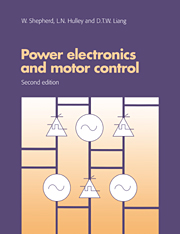Book contents
- Frontmatter
- Contents
- Preface to first edition
- Preface to second edition
- List of principal symbols
- 1 Power switching theory
- 2 Switching devices and control electrode requirements
- 3 System realisation
- 4 Adjustable speed drives
- 5 D.c. motor control using a d.c. chopper
- 6 Controlled bridge rectifiers with d.c. motor load
- 7 Three-phase naturally commutated bridge circuit as a rectifier or inverter
- 8 Single-phase voltage controllers
- 9 Three-phase induction motor with constant frequency supply
- 10 Induction motor slip-energy recovery
- 11 Induction motor speed control by the use of adjustable voltage, adjustable frequency step-wave inverters
- 12 Induction motor speed control by the use of adjustable frequency PWM inverters
- Appendix General expressions for Fourier series
- Answers to problems
- References and bibliography
- Index
3 - System realisation
Published online by Cambridge University Press: 05 June 2012
- Frontmatter
- Contents
- Preface to first edition
- Preface to second edition
- List of principal symbols
- 1 Power switching theory
- 2 Switching devices and control electrode requirements
- 3 System realisation
- 4 Adjustable speed drives
- 5 D.c. motor control using a d.c. chopper
- 6 Controlled bridge rectifiers with d.c. motor load
- 7 Three-phase naturally commutated bridge circuit as a rectifier or inverter
- 8 Single-phase voltage controllers
- 9 Three-phase induction motor with constant frequency supply
- 10 Induction motor slip-energy recovery
- 11 Induction motor speed control by the use of adjustable voltage, adjustable frequency step-wave inverters
- 12 Induction motor speed control by the use of adjustable frequency PWM inverters
- Appendix General expressions for Fourier series
- Answers to problems
- References and bibliography
- Index
Summary
INTRODUCTION
The final decision regarding the choice of switching devices and ancillary components must depend on the overall design for total system realisation. Any choice between device options is likely to have an interactive effect on other components. For example, the selection of a certain switching device for use in a particular circuit may or may not require switching aids and/or sophisticated protection. A relatively inexpensive electronic switching device may require ancillary circuitry that is prohibitive in cost, volume requirement, heat generation, excessive control circuit requirements, etc.
A consideration of some of the circuit features listed in the previous paragraph may be grouped under the general heading of ‘circuit protection.’ This, in turn, may be divided between the major classifications of ‘preventive protection’ and ‘abuse protection.’
Preventive protection is required so that when a device is operational it is embedded in an environment which prevents certain secondary device ratings from being exceeded. A typical example of this is the use of snubber circuits, which is adopted to prevent spurious triggering due to transients.
Abuse protection is required to cope with fault conditions which cause the normal primary ratings of the device to be exceeded. Typical examples are overvoltage or current surges arising from short circuiting of the load. In terms of Fig. 2.2 above, the inside or circuit user shell then dilates (i.e. enlarges) to transgress the outer or absolute maximum limit shell of the particular device design.
Information
- Type
- Chapter
- Information
- Power Electronics and Motor Control , pp. 94 - 120Publisher: Cambridge University PressPrint publication year: 1996
